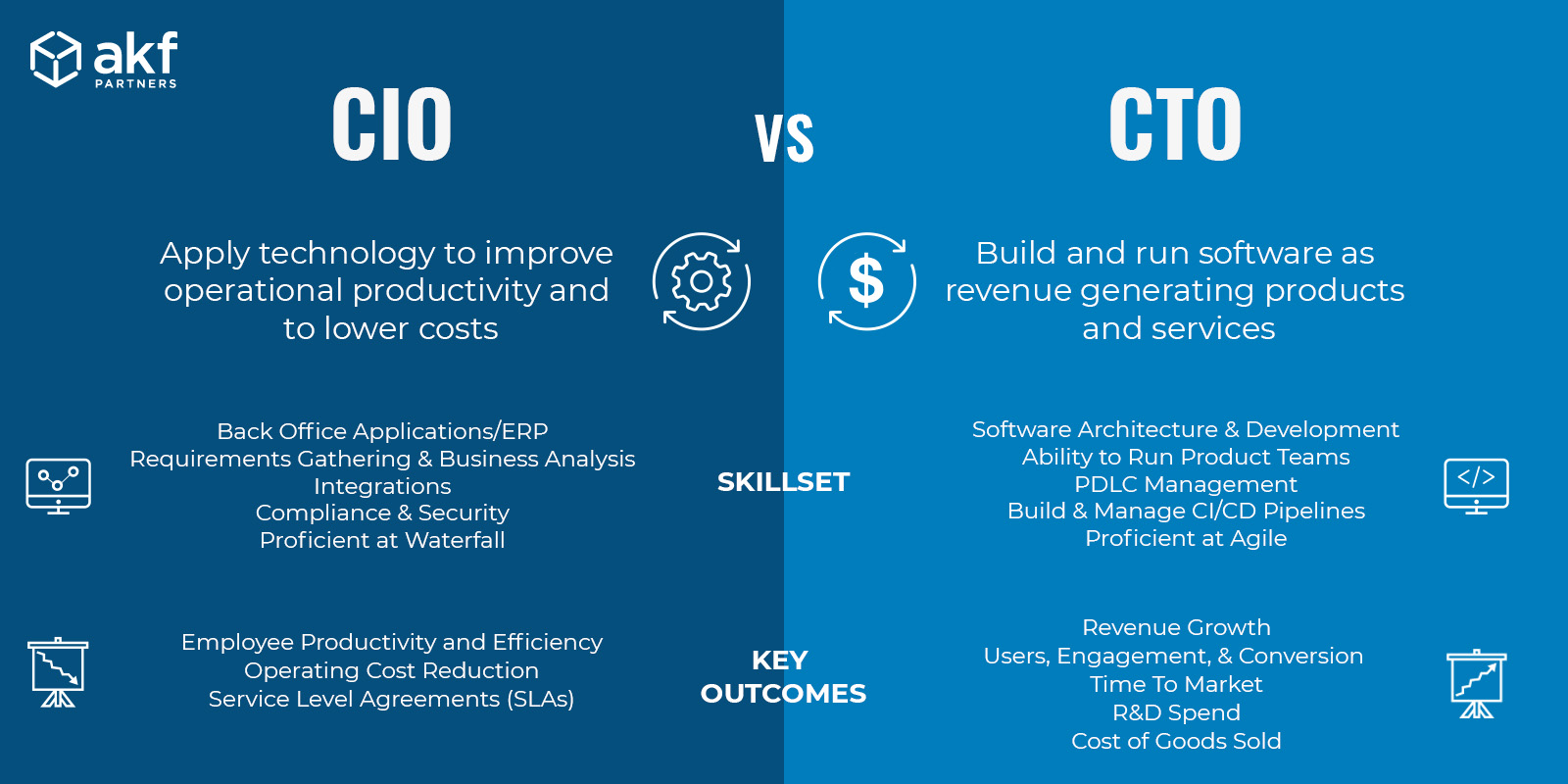The two most common types of technology due diligence requests we see at AKF are
- Product Technology Due Diligence
- Information Technology, or IT, Due Diligence.
Both types are very different from each other, but often get confused. This article will explain the differences between Product Technology and
Information Technology – and why understanding the difference is critical to a company’s success and profitability.
IT Department
An IT department is typically led by a Chief Information Officer (CIO). The focus of the CIO is on information technology that supports the ongoing operations of the business. The CIO and the IT team’s key outcomes are typically around employee productivity and efficiency, applying technology to improve productivity and to lower costs. This includes technologies that run the financial and accounting systems, sales and operations systems, customer support systems, and the networks, servers, and storage underlying these systems. The CIO is also responsible for the technologies that are used in the office such as email, chat, video conferencing systems, printers, and employees’ desktop computers.
Product Technology
Conversely, Product Technology (or Digital Product Technology) is typically led by a Chief Technology Officer (CTO). The focus of the CTO is building a product or service for customers out of software and running that product or service on cloud systems or company-owned systems, although the latter is becoming less common. Put another way, CTOs build and run software as revenue generating products and services.
Whereas the CIO runs a cost center and is responsible for employee productivity, the CTO is responsible for revenue and cash-flow. Sales growth, time to market, costs of goods sold, and R&D spend are some of the factors included within key outcomes for the CTO.
For example, if you were running a newspaper business, your primary product is the news. However, you also must build applications to read news like mobile apps and web apps. It is the job of your CTO to build, maintain, and run these apps for your customers. Your CTO would be accountable for business metrics – such as the number of downloads, users, and revenue. If your CTO is distracted by CIO issues of running the day-to-day business of the office, they are being taken away from their work to build and implement the revenue generating products and services your company is trying to create.
Differences
Product Technologies and IT Technologies are very different. CIOs and CTOs have very different skills and competencies to manage these differences. For example, a CIO often possesses deep knowledge of back-office applications such as accounting systems, finance systems, and warehouse management systems. In many cases they likely rose up through the technology ranks writing, maintaining, and running those systems for other departments in the company. They are excellent at business analysis, collecting requirements from company users and translating those requirements into project plans. CIOs are often proficient at waterfall development methodologies often used to implement back-office applications.
The IT team is often largely staffed with people who know how to integrate and configure third-party products, with a small amount of custom development. The opposite is true for most product technology teams typically staffed with software engineers who are building new solutions and a smaller number of engineers integrating infrastructure components.
CTOs possess entirely different technology skills needed to build and maintain software as a service (SaaS) for the company’s customers. CTOs possess the skills to architect software applications that are scalable as the company grows its customer base. The AKF Scale Cube is an invaluable reference tool for the CTO building a scalable software solution based on scalable microservices. CTOs must have the skills to run product teams, including user experience design, along with software development. CTOs are more likely to be proficient in Agile development methodologies, such as Scrum. CTOs are expected to know the product development lifecycle (PDLC), mitigate technical debt liability, and know how to build software release pipelines to support continuous integration and delivery(CI/CD).

What We See In The Wild
Regularly, when AKF is called to perform technology due diligence, we often find that Product and IT are combined! This has been especially true for older, established companies, with traditional IT departments. CIOs took on the responsibility of building and running customer-facing internet and mobile software products and services rather than creating a separate Product Development Team under a CTO. The results are often not positive because the technical, product, and process skills are very different between the two.
This mistake is not exclusive to older companies. We see startup CEO’s making the same mistake, often under the rationale of reducing burn. However, when a startup CEO looks to the CTO to help set up new employees’ desktop computers or to fix a problem with email, it is a huge distraction for the CTO who should be focused on building and improving the company’s revenue-generating products.
AKF Recommendations
AKF recommends that CEOs not combine Product Development and IT departments. Understanding this distinction and why these two very different departments need to function separately is critically important. Our primary expertise at AKF is to help successful companies become more successful at delivering digital products. AKF focuses its expertise on helping product development teams succeed. We have developed intellectual property, including the AKF Scale Cube, used to evaluate product architecture and to guide successful product development teams.
We also help CEOs, CTOs, CIOs and IT departments who are looking to improve performance and deliver more business value by creating efficient product development processes and architectures. Give us a call, we can help!